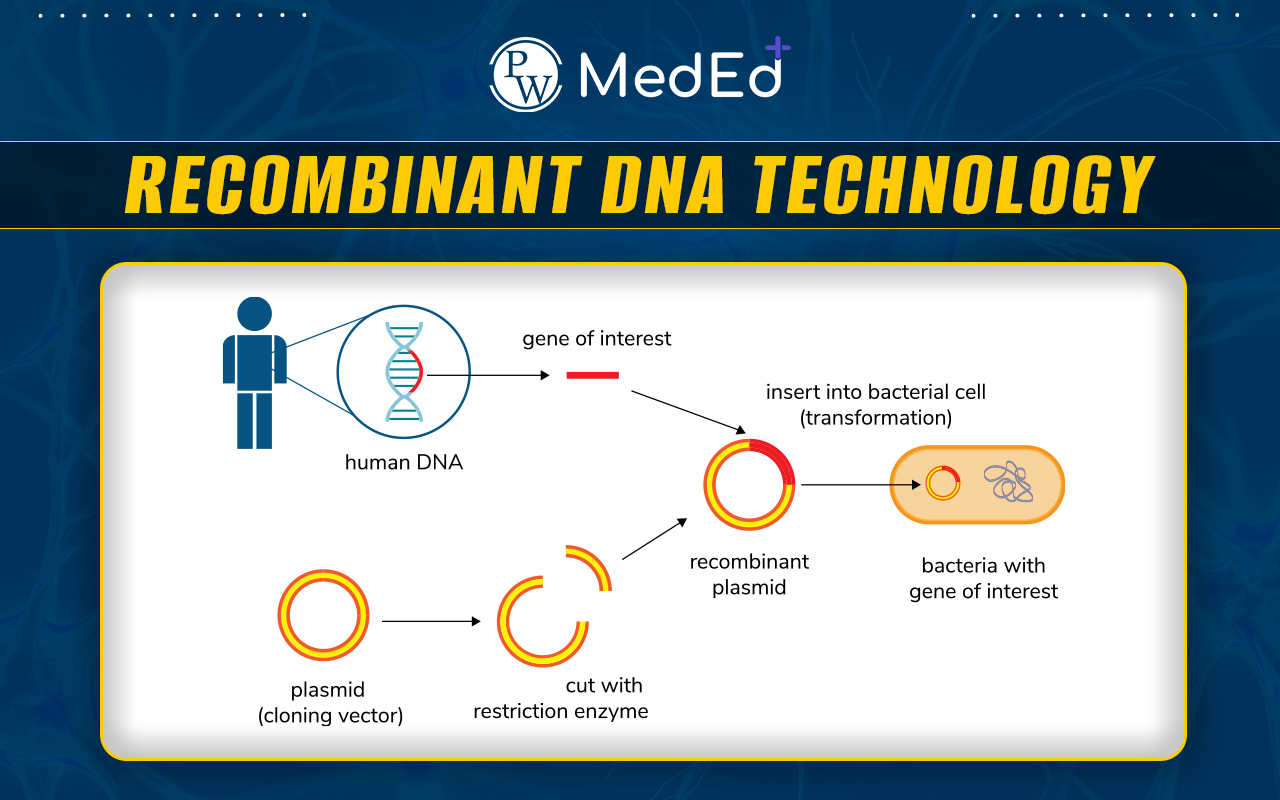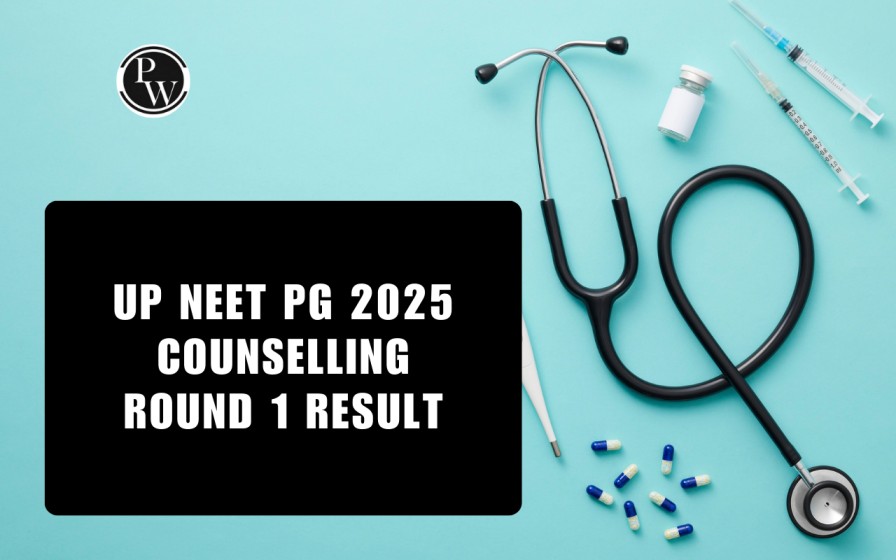

Recombinant DNA technology : revolutionary technology which enabled mankind to alter genes. Recombinant DNA technology is the joining together of DNA molecules from two different species . The recombinant DNA molecule is inserted into a host organism to produce new genetic combinations that are of value to science, medicine, agriculture, and industry.
Visit – MedEd App
Read More - Radiodiagnosis
History
The possibility for recombinant DNA technology emerged with the discovery of restriction enzymes( enzyme molecule catalyzes break in DNA at specific location) in 1968 by Swiss microbiologist Werner Arber. The following year American microbiologist Hamilton O. SMITH purified so-called type II restriction enzymes, which were found to be essential to genetic engineering.Some Important Terminology
Vector A vector, as related to molecular biology, is a DNA molecule (often plasmid or virus) that is used as a vehicle to carry a particular DNA segment into a host cell as part of a cloning or recombinant DNA technique. Host The vector containing the insert is called recombinant DNA (rDNA). Subsequently, the rDNA is introduced into an organism referred to as host. Restriction enzymes A restriction enzyme is a protein isolated from bacteria that cleaves DNA sequences at sequence-specific sites, producing DNA fragments with a known sequence at each end. Selectable markers Selectable markers are important in gene cloning because they help identify and eliminate non-transformants( cells which did not take up the rDNA) while allowing transformants to grow.Read More - Pharyngeal Arches
Methods Of Recombinant DNA Technology
There are three different methods of producing recombinant DNA, namely transformation, non-bacterial transformation, and phage. Transformation Transformation and non-bacterial transformation are similar processes, with the only difference being the use of bacteria such as E. Coli for the host. While the transformation process uses Escherichia coli to act as a biological framework. Non-bacterial transformation Non - bacterial method does not use any bacteria – as is evident in the name. Initially, one needs to choose which DNA segment to insert into the vector. Phage introduction Phage: a virus that infects bacteria, its introduction is the process of transfection, which is equivalent to transformation, but in this process, a phage is used instead of bacteria.Read More - Pelvis and Perineum
Tools of Recombinant DNA Technology
The DNA sequences used in the construction of recombinant DNA molecules can originate from any eukaryotic species, be it human, bacterial, fungal or mammalian cells. The different molecular biology tools used in rDNA technology include DNA isolation and analysis, molecular cloning, quantification of gene expression, determination of gene copy number, a selectable marker, or transfer into crop plants and analyses of transgenic plants. Respectively, some of the most important instruments needed are enzymes, gene cloning vectors, polymerase chain reaction (PCR) and host organisms.Steps
Recombinant DNA is composed of sequences that are derived from different sources. The process to achieve this involves the following steps:- Isolation of genetic material
- Cutting of DNA at specific locations with the help of enzymes.
- Joining of DNA fragments by ligation.
- Insertion of DNA into the host cell
- Selection and screening of transformed cells ( transformed cells are cells that have taken up recombinant DNA and express the genes encoded in that DNA.)
Uses of GMO
The recombinant organisms are called as genetically modified organisms. Agricultural plants are one of the most frequently cited examples of genetically modified organisms (GMOs). Some benefits of genetic engineering in agriculture are increased crop yields, reduced costs for food or drug production, reduced need for pesticides, enhanced nutrient composition and food quality, resistance to pests and disease, greater food security, and medical benefits to the world's growing population. The pharmaceutical industry is another frontier for the use of GMOs.Recombinant DNA Technology FAQs
What is recombinant DNA technology?
Recombinant DNA technology is the process of joining DNA molecules from two different species and inserting the recombined DNA into a host organism to create new genetic combinations. These combinations have applications in science, medicine, agriculture, and industry.
What is a vector and host in the context of molecular biology?
A vector is a DNA molecule, such as a plasmid or virus, used as a vehicle to carry a specific DNA segment into a host cell during cloning or recombinant DNA techniques.Host is referred as an organism in which recombinant DNA is introduced.
What role do restriction enzymes play in recombinant DNA technology?
Restriction enzymes are proteins isolated from bacteria that cut DNA sequences at specific sites. This allows scientists to create DNA fragments with known sequences at each end, which are crucial for recombining DNA from different sources.
What are some of the tools and instruments used in recombinant DNA technology?
Tools and instruments used in recombinant DNA technology include enzymes, gene cloning vectors, polymerase chain reaction (PCR), host organisms, DNA isolation and analysis methods, and tools for quantifying gene expression and determining gene copy number.
Talk to a counsellorHave doubts? Our support team will be happy to assist you!

Free Learning Resources
PW Books
Notes (Class 10-12)
PW Study Materials
Notes (Class 6-9)
Ncert Solutions
Govt Exams
Class 6th to 12th Online Courses
Govt Job Exams Courses
UPSC Coaching
Defence Exam Coaching
Gate Exam Coaching
Other Exams
Know about Physics Wallah
Physics Wallah is an Indian edtech platform that provides accessible & comprehensive learning experiences to students from Class 6th to postgraduate level. We also provide extensive NCERT solutions, sample paper, NEET, JEE Mains, BITSAT previous year papers & more such resources to students. Physics Wallah also caters to over 3.5 million registered students and over 78 lakh+ Youtube subscribers with 4.8 rating on its app.
We Stand Out because
We provide students with intensive courses with India’s qualified & experienced faculties & mentors. PW strives to make the learning experience comprehensive and accessible for students of all sections of society. We believe in empowering every single student who couldn't dream of a good career in engineering and medical field earlier.
Our Key Focus Areas
Physics Wallah's main focus is to make the learning experience as economical as possible for all students. With our affordable courses like Lakshya, Udaan and Arjuna and many others, we have been able to provide a platform for lakhs of aspirants. From providing Chemistry, Maths, Physics formula to giving e-books of eminent authors like RD Sharma, RS Aggarwal and Lakhmir Singh, PW focuses on every single student's need for preparation.
What Makes Us Different
Physics Wallah strives to develop a comprehensive pedagogical structure for students, where they get a state-of-the-art learning experience with study material and resources. Apart from catering students preparing for JEE Mains and NEET, PW also provides study material for each state board like Uttar Pradesh, Bihar, and others
Copyright © 2025 Physicswallah Limited All rights reserved.
Get App










